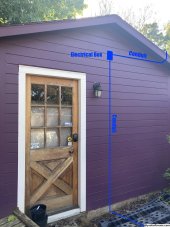Influencer
New Member
- Joined
- Mar 6, 2021
- Messages
- 25
Hello,
I’m planning a small solar setup connected to a battery. I want to run 8 awg solar panel cables into my detached ‘garage’, which is a small non-livable 10 ft x 20 ft building, which has its own power but I’m NOT connecting the solar system to the grid, i'm just using a transfer switch that switches from the battery to an outlet when the battery is low.
I plan to have two 100 watt panels on stands in my yard to start, and eventually expand that to two more on the roof of the garage. So 400 Watts total. Though I may eventually expand this to 800-1000 watts in the distant future.
It’s always scary putting holes in buildings, so I wanted to run my concept for getting the solar cables into my garage by the forum. My current thoughts are to use PVC conduit up to an electrical box on the side of the building, as pictured. At first it would just be the conduit coming up vertically from the panels in my yard, but once I get panels on the roof I would also run those cables in through the side of the same electrical box.
How does this placement look? Is there any practical considerations I should have placement wise, and component/material/safety wise? And is there any potential general regulatory things I should consider - I understand this varies by region and I would need to run it by the city if I want to be fully compliant, I’m just seeing what you all have to say while I’m in the planning stage.
Thanks!
I’m planning a small solar setup connected to a battery. I want to run 8 awg solar panel cables into my detached ‘garage’, which is a small non-livable 10 ft x 20 ft building, which has its own power but I’m NOT connecting the solar system to the grid, i'm just using a transfer switch that switches from the battery to an outlet when the battery is low.
I plan to have two 100 watt panels on stands in my yard to start, and eventually expand that to two more on the roof of the garage. So 400 Watts total. Though I may eventually expand this to 800-1000 watts in the distant future.
It’s always scary putting holes in buildings, so I wanted to run my concept for getting the solar cables into my garage by the forum. My current thoughts are to use PVC conduit up to an electrical box on the side of the building, as pictured. At first it would just be the conduit coming up vertically from the panels in my yard, but once I get panels on the roof I would also run those cables in through the side of the same electrical box.
How does this placement look? Is there any practical considerations I should have placement wise, and component/material/safety wise? And is there any potential general regulatory things I should consider - I understand this varies by region and I would need to run it by the city if I want to be fully compliant, I’m just seeing what you all have to say while I’m in the planning stage.
Thanks!



